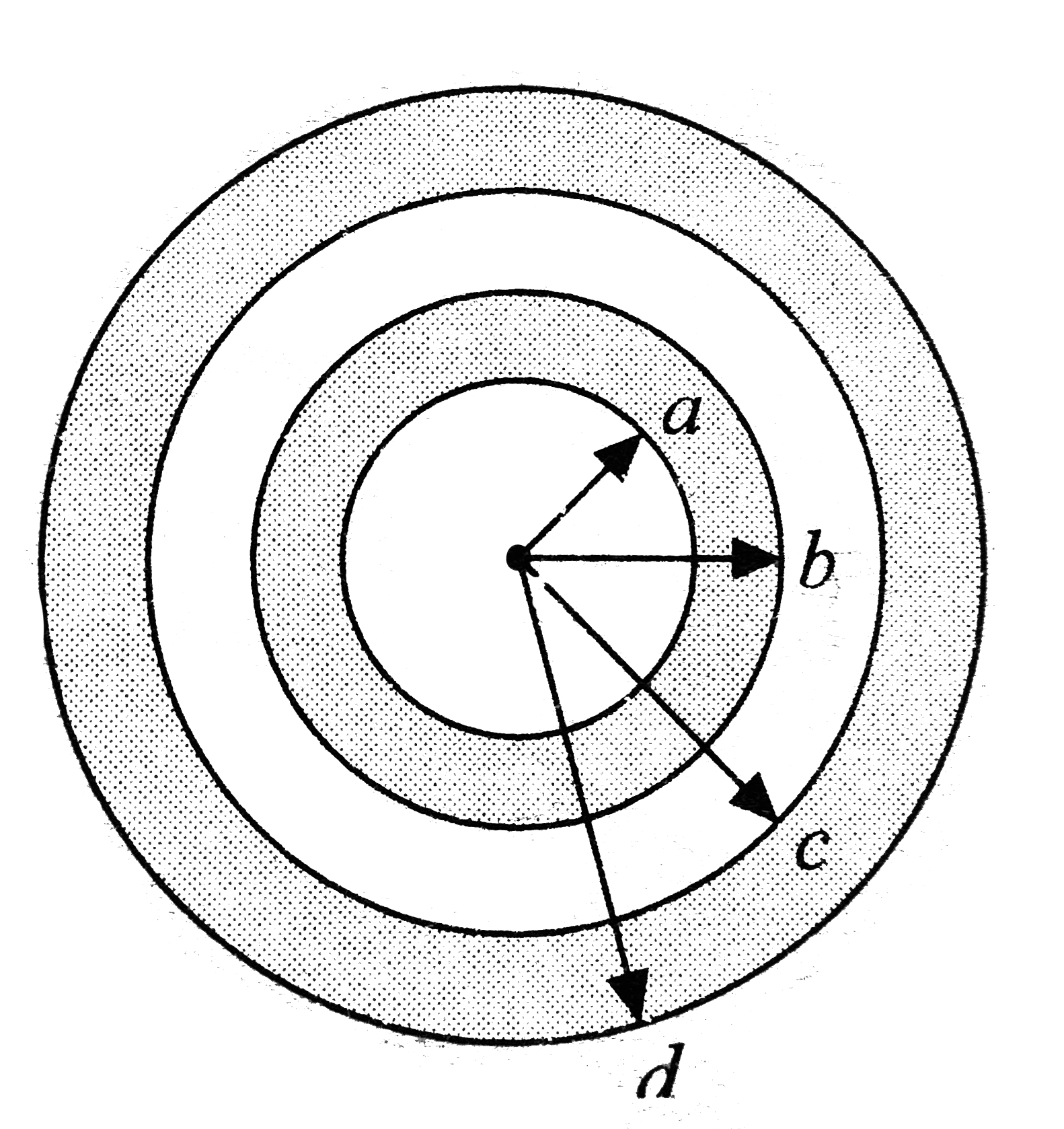A spherical shell has inner radius , outer radius , and mass M, distributed uniformly throughout the shell. The magnitude of the gravitational force exerted on the shell by a point mass particle of mass m, located at a distance d from the center, inside the inner radius, is:
a.0
b.
c.
d.
The correct Answer is:A
To find the magnitude of the gravitational force exerted on a spherical shell by a point mass located inside the inner radius, we can follow these steps:
1. Understanding the Setup:
- We have a spherical shell with an inner radius R1 and an outer radius R2.
- The shell has a uniform mass M distributed throughout it.
- A point mass m is located at a distance d from the center, where d<R1.
2. Applying Gauss's Law for Gravitation:
- According to Gauss's Law for gravitation, the gravitational field Eg inside a spherical shell (at a distance less than the inner radius) is zero. This is because the mass enclosed within a Gaussian surface inside the shell is zero.
- Mathematically, we can express this as:
∮Eg⋅dS=−4πG⋅Menclosed
- Since Menclosed=0 (there is no mass inside the Gaussian surface), we have:
∮Eg⋅dS=0
- This implies that the gravitational field Eg inside the shell is:
Eg=0
3. Calculating the Gravitational Force:
- The gravitational force F experienced by the point mass m due to the gravitational field Eg is given by:
F=m⋅Eg
- Since we have established that Eg=0:
F=m⋅0=0
4. Conclusion:
- Therefore, the magnitude of the gravitational force exerted on the shell by the point mass located inside the inner radius is:
F=0N
Final Answer:
The gravitational force exerted on the shell by the point mass is 0N.
---
- We have a spherical shell with an inner radius R1 and an outer radius R2.
- The shell has a uniform mass M distributed throughout it.
- A point mass m is located at a distance d from the center, where d<R1.
- According to Gauss's Law for gravitation, the gravitational field Eg inside a spherical shell (at a distance less than the inner radius) is zero. This is because the mass enclosed within a Gaussian surface inside the shell is zero.
- Mathematically, we can express this as:
∮Eg⋅dS=−4πG⋅Menclosed
- Since Menclosed=0 (there is no mass inside the Gaussian surface), we have:
∮Eg⋅dS=0
- This implies that the gravitational field Eg inside the shell is:
Eg=0
- The gravitational force F experienced by the point mass m due to the gravitational field Eg is given by:
F=m⋅Eg
- Since we have established that Eg=0:
F=m⋅0=0
- Therefore, the magnitude of the gravitational force exerted on the shell by the point mass located inside the inner radius is:
F=0N
The gravitational force exerted on the shell by the point mass is 0N.
Topper's Solved these Questions
- BOOK - VMC MODULES ENGLISHCHAPTER - GRAVITATIONEXERCISE - Level-230videos
GRAVITATION
- BOOK - VMC MODULES ENGLISHCHAPTER - GRAVITATIONEXERCISE - JEE Main (Archive)43videos
GRAVITATION
- BOOK - VMC MODULES ENGLISHCHAPTER - GRAVITATIONEXERCISE - LEVEL -0 Long Answer Type3videos
GRAVITATION
- BOOK - VMC MODULES ENGLISHCHAPTER - GASEOUS STATE & THERMODYNAMICSEXERCISE - JEE ADVANCED (ARCHIVE )111videos
GASEOUS STATE & THERMODYNAMICS
- BOOK - VMC MODULES ENGLISHCHAPTER - INTRODUCTION TO VECTORS & FORCES EXERCISE - JEE Advanced ( ARCHIVE LEVEL-2)12videos
INTRODUCTION TO VECTORS & FORCES
Similar Questions
A metallic spherical shell has an inner radius R1 and outer radius R2. A charge is placed at the centre of the spherical cavity. The surface charge density on the inner surface is
 View Solution
View SolutionThe electrostatic potential of a uniformly charged thin spherical shell of charge Q and radius R at a distance r from the centre
View Solution
Knowledge Check
- Question 1 - Select One
A point mass m is placed inside a spherical shell of radius R and mass M at a distance R2 form the centre of the shell. The gravitational force exerted by the shell on the point mass is
AGMmR2B2GMmR2CzeroD4MmR2 - Question 2 - Select One
A particle of mass M is placed at the centre of a spherical shell of same mass and radius a. What will be the magnitude of the gravitational potential at a point situated at a/2 distance from the centre ?
A−3GMRB−2GMRC−GMRD−4GMR
Find the gravitational potential due to a spherical shell of mass M and radius R at r<R and r>R, where r is the distance from the centre of the shell.
View SolutionA point charge Q is placed inside a conducting spherical shell of inner radius 3R and outer radius 5R at a distance R from the centre of the shell. The electric potential at the centre of the shell will be
View SolutionA metal spherical shell has an inner radius R1 and outer radius R2. A charge Q is placed at the center of the spherical cavity. What will be surface charge density on (i) the inner surface, and (ii) the outer surface ?
View SolutionTwo concentric spherical shells have masses M1,M2 and radii R1,R2(R1<R2). What is the force exerted by this system on a particle of mass m if it is placed at a distance R1+R22 from the center?
View SolutionA fixed spherical shell of inner radius R and outer radius 2R has mass M, A particle of mass m is held at rest at a distance 2R from the surface of the body. If the particle is released from that point, with what speed will it hit surface of the spherical body ?
View SolutionA small conducting spherical shell with inner radius a and outer radius b is concentric with a larger conducting spherical shell with inner radius c and outer radius d ( as shown in Fig . 2.121). The inner shell has a total charge +2q, and the outer shell has a total charge +4q. Calculate the electric field in terms of q and the distance r from the common center of the two shells for

r<aView Solution

